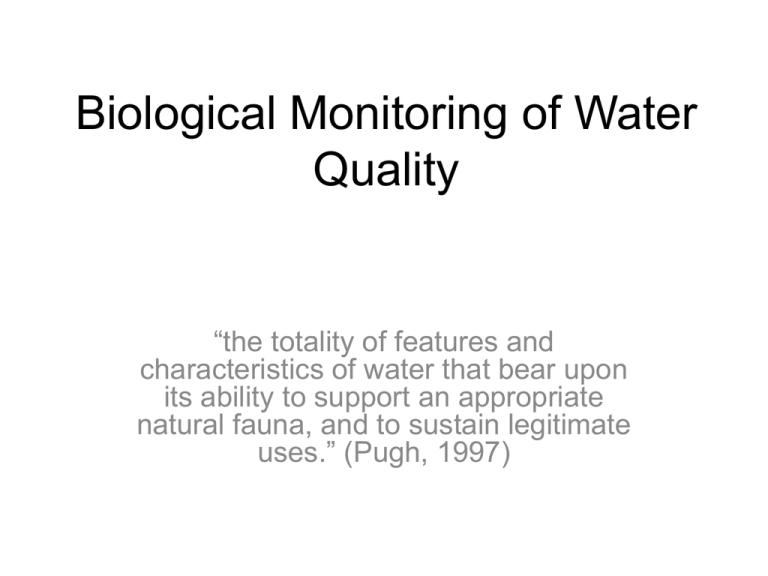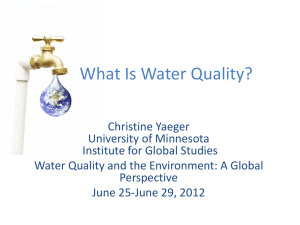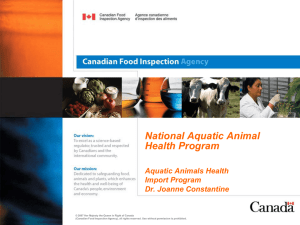Biological Monitoring of Water Quality
advertisement

Biological Monitoring of Water Quality “the totality of features and characteristics of water that bear upon its ability to support an appropriate natural fauna, and to sustain legitimate uses.” (Pugh, 1997) The 3 components of management of ecological quality in rivers Quality Ecological Quality Quantity Structure General Quality Assessment Biology Chemistry Water Quality Nutrients Aesthetics GQA Scheme for Biology • A = Very Good – Biology similar (or better than) that expected for an average and unpolluted river of this size, type and location. High diversity of taxa, usually with several species in each. Rare to find dominance of any one taxon. • B = Good C = Fairly Good, D = Fair, E = Poor • F = Poor – Biology limited to a small number of very tolerant taxa such as worms, midge larvae, leeches and water hoglouse, present in very high numbers. Water Framework Directive (2000) WFD looks at the whole system; seeks to manage water proactively on a catchment basis, using reference systems Aims: 1. To achieve “Good Status” for all waters by set deadlines (2015) 2. To promote sustainable water consumption 3. To protect & enhance the status of aquatic ecosystems & associated wetlands Water management to be based on natural units not natural ones Aquatic Invertebrates Sampling Identification Using aquatic inverts as indicators of biological water quality What are Aquatic Macro-invertebrates? Aquatic Invertebrates - Examples Why Sample Aquatic Invertebrates? 1. Aquatic inverts are ecologically important within the food chain – - abundance - species and ecological diversity Functional roles include: •Algal grazers •Consumers of bacteria & fungi •Detritivores •Predators •Prey Why Sample Aquatic Invertebrates cont. ? 2. Aquatic Invertebrates vary in their sensitivity to water pollution i.e. they are good biological indicators 3. Aquatic invertebrate data provides longer term information than chemical data 4. Sampling aquatic invertebrates is more meaningful than chemical monitoring 5. Aquatic invertebrates are relatively easy to collect Collecting Samples Health and Safety first! 1. Prepare necessary methods statement and risk assessment Collecting Samples 2. Check mobile phone, put on life jacket 3. Review bank features including slope, vegetation, conditions underfoot, obstacles or special hazards 4. Review waterbody features including depth, turbidity, flow, substrate, channel profile, vegetation, obstacles or special hazards Collecting Samples 5. Together with co-worker, identify point(s) of entrance and exit 6. Use ranging pole to test substrate and provide support 7. Go slowly 8. Common Sense Rule: Don’t get in if there is any doubt over safety Collecting Samples 4 – Minute Combined Kick-sweep Sample – 30 seconds collection of surface activity insects – 3 minute kicking and sweeping – 30 seconds collection of benthic invertebrates adherent to stones, logs, car tyres and shopping trolleys Key Point: Important to divide time between component habitats or microhabitats proportionally E.g. Open water, submerged vegetation, emergent vegetation, exposed substrate, overhanging vegetation, submerged wood Sample Storage Either a three stage process: • Firstly: apply a fixative, usually 4% aqueous solution of formaldehyde • Secondly: sort sample, i.e. pick out inverts • Thirdly: store sorted sample in a preservative, usually 70% alcohol Or; simply use 90% alcohol (IMS) Sorting a Sample • Wash out fixative • ‘Dilute’ sample across a white tray • Carefully pick out the invertebrates Review of Aquatic Invertebrate Groups Crustacea – Water Fleas Crustacea – Freshwater Shrimp Platyhelminthes - Flatworms Annelida – Hirudinea - Leeches Mollusca – Gastropoda - Snails Insecta – Hemiptera – Water Bugs Insecta – Coleoptera – Water Beetles Insecta – Diptera – True Flies Insecta – Megaloptera - Alderflies Insecta – Tricoptera – Caseless Caddis Flies Insecta – Tricoptera – Cased Caddis Flies Insecta – Tricoptera - Adult Caddis Fly Insecta – Plecoptera – Stone-flies Insecta –Ephemeroptera - Mayflies Insecta – Ephemeroptera – Adult Mayfly Insecta – Odonata – Dragonflies & Damselflies Data Interpretation Calculate the Biotic Scores • Taxon or species richness; the easiest measure of biodiversity • BMWP score; the Biological Monitoring Working Party score • ASPT index value; the Average Score Per Taxon BMWP Scale BMWP score Category Interpretation 0-10 Very poor Heavily polluted 11-40 Poor Polluted or impacted 41-70 Moderate Moderately impacted 71-100 Good Clean but slightly impacted >100 Very good Unpolluted, unimpacted BWMP – Score dependent on sample size, sampling efficiency and seasons Different unpolluted rivers often generate very different BMWP scores due to natural variation in ecological communities eg. silted lowland rivers with turbulent upland streams. The solution ? RIVPACS In this system the different river types are taken into account Mesolveliidae Hydrometridae Gerridae Nepidae Naucoridae Notonectidae Pleidae Corixidae Haliplidae Hygrobiidae Dytiscidae Gyrinidae Hydrophilidae Clambidae Scirtidae Dryopidae Eliminthidae Chrysomelidae Curculionidae Hydropsychidae Tipulidae Simuliidae Planariidae Dendrocoelidae Baetidae Sialidae Piscicolidae Valvatidae Hydrobiidae Lymnaeidae Physidae Planorbidae Sphaeriidae Glossiphoniidae Hirudidae Erpobdellidae Asellidae Chironomidae Oligochaeta (whole class) 5 4 3 2 1 Data Interpretation • Compare sampling stations, e.g. up and downstream of potential pollution source • Compare with historical data • Compare with Environment Agency data BMWP at sites along the Tory Brook & River Plym BMWP Score 100 90 80 70 60 50 40 30 20 10 0 1 2 3 4 5 6 River Plym Tory Brook Site Average score per Taxon at sites along the Tory Brook & River Plym 10 9 Average Score per Taxon 8 7 6 5 4 3 2 1 0 1 2 3 Site 4 5 6 River Plym Tory Brook Evidence of china clay in the water Site two at the Tory Brook Evidence that channel may have be altered Site six at the Tory Brook Suspended Solids at sites along the Tory Brook & River Plym Suspended Solids (mg/l) 30 27.5 25 22.5 20 17.5 15 12.5 10 7.5 5 2.5 0 1 2 3 4 Site 5 6 River Plym Tory Brook Site one at the River Plym Site two at the River Plym Site four at the River Plym Phosphate at sites along the Tory Brook & River Plym 0.7 Phosphate (mg/l) 0.6 0.5 0.4 0.3 0.2 0.1 0 1 2 3 Site 4 5 6 River Plym Tory Brook Nitrate at sites along the Tory Brook & River Plym 16 Nitrates (mg/l) 14 12 10 8 6 4 2 0 1 2 3 Site 4 5 6 River Plym Tory Brook References Bourne Stream. 2008. BMWP Scoring – measuring Freshwater Quality [online] Available at http://www.bournestreampartnership.org.uk/bmwpscoring.htm [Accessed 23rd March 2008] Centre for Ecology & Hydrology. 2008. RIVPACS (River Invertebrate Prediction and Classification System): an introduction. [Online] Available at: http://www.ceh.ac.uk/sections/re/RIVPACS.html [Accessed 2nd April 2008] DEFRA. 2006. Key Facts about: Inland Water Quality and Use, Phosphate Concentrations in rivers: 1995-2005. [Online]. Available at: http://www.defra.gov.uk/environment/statistics/inlwater/kf/iwkf09.htm [Accessed 4th April 2008] Environmental Agency. ND. General Quality Assessment of rivers – biology, [Online] Available at: http://www.environmentagency.gov.uk/commondata/acrobat/bio_method_09_03_559881.pdf [Accessed 19th November 2007] EPA, 2007. Biological Indicators of Watershed Health. [Online] (Updated 30th November 2007) Available at: http://www.epa.gov/bioindicators/html/indicator.html [Accessed 20th March 2008] Gainey P. 2007. Cornish mineral company fined for polluting salmon river. [Online] Available at: http://www.environmentagency.gov.uk/news/1901125 [Accessed 4th April 2008] Hawkes H. 1997. Technical Note, Origin and Development of the Biological Monitoring Working Party Score System, 32 (4) Pages 964-968 Martin R. 2004. Origin of the Biological Monitoring Working Party System, A brief summary, [Online] Available at http://www.cies.staffs.ac.uk/origbmwp.htm [Accessed 20th November 2007]









